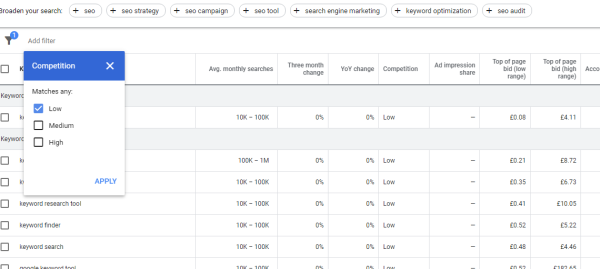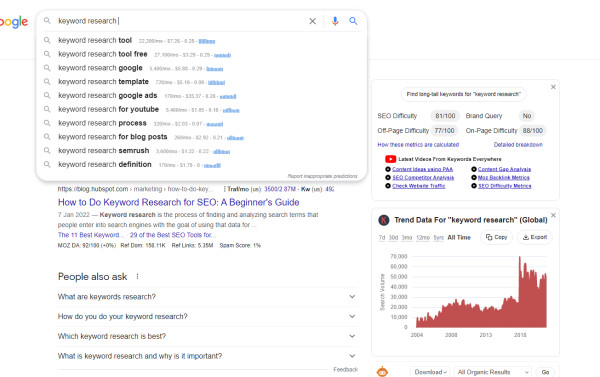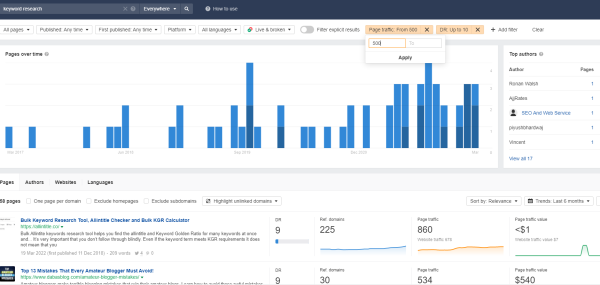No products in the cart.
SEO
High Competition Or Low Competition Keywords? (Increase Traffic)
Summary
There is a lot of truth to the statement that high competition keywords are difficult to rank for. This is because these keywords are popular and many other websites are also targeting them. However, this doesn’t mean that you can’t rank for them – it just means that you need to put in a lot more effort.
Another way to target high competition keywords is by using long-tail keywords. These are keywords that are less popular but still have a high search volume. Long-tail keywords are easier to rank for than high competition keywords, and they can be a great way to attract more traffic to your website.
We will explore how to rank for high competition keywords and low competition keywords with high search volume, how to discover the keyword opportunities, assess the competition and work out if we can rank for them to increase our traffic and conversions.
Targeting High Competition Keywords
So you want to find high competition keywords? It’s not as hard as it may seem. There are a few key steps you need to follow in order to identify high competition keywords that will be a challenge to rank for but can also generate a lot of traffic.
Let’s take a look.
The first step is to lay the groundwork. Make sure your website is optimized for SEO and that you have a strong foundation. This includes having quality content, backlinks, and good on-page optimization.
Once you’ve done that, you can move on to the next step: doing your initial keyword research. This involves finding keywords relevant to your topic that you want to rank for. You can use Google’s Keyword Planner Tool or Ahrefs to find this information.
Once you’ve found a few good keywords, it’s time to check out the competition. Use either of the tools mentioned above to measure how difficult it will be to rank for that keyword. The higher the competition, the harder it will be to rank in Google.
However, it’s not all about ranking in Google. You also need to consider intent. What is the intent of the person searching for this keyword? Is it informational? Commercial? Do they want to buy something? Once you have an idea of the intent, you can tailor your content accordingly.
Now that you have a good understanding of the keyword and its intent, it’s time to conceptualize the content. This involves coming up with a topic and outline for your article. Once you have that, it’s time to execute.
Once you’ve written the article, it’s time to publish it. Make sure to share it on social media and promote it as much as possible.
Once you’ve published the article, it’s time to start tracking its success. Use Google Analytics or another analytics tool to measure how well the article is performing. If it’s not doing as well as you’d like, go back and tweak some of the elements until you see an improvement.
And that’s how you find high competition keywords! By following these steps, you can identify keywords that are a challenge to rank for but can also generate a lot of traffic.

Keyword Tools Assess The High Competition And Low Competition
In order to assess the competition of a keyword, you can use a variety of different tools. One of the most popular is Ahrefs. This tool shows how often a specific term is searched for on Google, as well as how much competition there is for it. You can also use other free tools such as the Google keyword planner Tool or Keywords Everywhere.
We will look at these tools, and how to use them effectively.
Google Keyword Planner
The Google AdWords Keyword Tool is a great way to get ideas for new keywords to target in your AdWords campaigns. You can use it to see how competitive the keywords are, so you can focus on the ones that have the lowest competition.
This is a great way to find profitable keywords that you may not have thought of before. And since most people use broad match, you may be able to find some hidden gems that haven’t been targeted by many others.
Targeting the right keywords is essential for a successful keyword strategy. By using the Google AdWords Keyword Tool, you can make sure you’re targeting the right ones.
When doing keyword research, it’s important to consider the average monthly search volume for those keywords. This will help you to determine how competitive the keyword is, and if it is possible to rank for. You can use the filters on the Google AdWords Keyword Planner to narrow down your results based on average monthly searches.
You’ll also want to consider the suggested bid. This is the amount that Google is recommending you pay for each click on ads. It takes into account how much other advertisers are spending for keywords with the same settings as you.

When doing your research, it’s important to find keywords that are both relevant and have a high search volume, but have low difficulty. If your website is new you will want to avoid high competition keywords, as you will often find hidden gems with good volume for less competitive terms.
The competition keyword filter will help you to find keywords that you can rank for more easily. The filter will show you keywords that have a lower difficulty, making it easier for you to rank for them. This can be helpful for small businesses that want to make the most of their budget.

Ahrefs
If you’re looking to write about keywords, using a tool like Ahrefs can be really helpful. Plugging in your topic ideas into Keywords Explorer can give you a list of related keywords, along with monthly search volumes and other SEO metrics.
When doing keyword research, it’s important to look for keywords that are low-competition but still make sense for the content you want to create. That way, you’ll have a better chance of ranking for them.

You can filter KD (keyword difficulty) score between 0-10 to get a list of low-competition keywords. If you are a new website it is best to target KD of 5 or below anything above 10 is considered medium to high competition.
Of course, simply finding a low-competition keyword doesn’t mean you’ll be able to rank for it. You still need to create content that searchers are looking for. Make a list of keywords that your target audience is likely to use in Google and write them down! It’s always best to check out the search intent first.
Keywords Everywhere
The Keywords Everywhere extension is a great tool for helping to research and compare keywords. As it connects to your favorite keyword research tool, it seamlessly appends search traffic data, CPC, and competition data.
Now you can see all the relevant search volume data in real-time while you’re on Google, and any other platform you use for research.
This extension is especially helpful for those in SEO (search engine optimization) and PPC (pay-per-click) industries, as it allows access to keyword data for any list of keywords letting you download the list in Excel and other file formats. This gives you the ability to fine-tune your campaigns and see what keywords are generating the most traffic and conversions.

If you’re not sure where to start when looking for new keywords, this extension can help. One of the best methods to use with Keywords Everywhere is to type your keyword in google, then you will see google suggestions and people also ask for help to identify popular keywords related to your topic.
This extension makes finding the right keywords easier than ever, so you can focus on what’s important – creating great content that engages your audience.
How to analyze high or low competition keywords
Da or PA Of A Website/ Number Of Backlinks To The Page
When looking at high competition keywords, it is important to analyze them in order to determine whether or not they are worth targeting. One way to do this is by looking at the Domain Authority (DA) or Page Authority (PA) of a website. You can also use the Ahrefs Chrome extension to get data on the number of referring domains and keywords that a URL ranks for.
After a few searches, you may find a long-tail topic that is worth targeting. Although the volume may not be as high as other keywords, it is still important to consider long-tail traffic. 200 may not seem like a lot, but it can be worthwhile if it results in conversions.
When looking at the competition for a keyword, it’s important to remember that the metric isn’t always 100% accurate. Ahrefs measures the keyword difficulty of a particular keyword by taking into account the number of links needed to rank in the top 10. However, I’ve found that this metric isn’t always true – Sometimes you will be able to rank #2 for a term with just one backlink, so it’s critical to consider all variables when assessing keyword competition.

When you’re looking for high volume, low competition keywords, it’s important to use a tool like the Ahrefs Content Explorer. This will help you to filter out any pages that are not ranking for anything, as well as pages with high competition.
Instead, you’ll want to focus on pages that have low competition and high traffic. You can do this by setting the organic traffic filter to “From: 500”. This will show you pages that rank for over 500, meaning these pages get a significant amount of traffic.
Then, you can investigate the other sites that showed up in the list and jot down the other keywords you want to hit in your blog.
conclusion
Targeting high competition keywords may seem daunting, but it’s important to remember that not all of these keywords are worth targeting. By analyzing the Domain Authority (DA) or Page Authority (PA) of a website, as well as the number of referring domains and keywords that a URL ranks for, you can get an idea of whether or not it is worth your time to target a particular keyword.
You can also use the Ahrefs Chrome extension to get data on the number of referring domains and keywords that a URL ranks for.
After doing some research, you may find a long-tail topic that is worth targeting – even if the volume isn’t as high as other keywords. 200 may not seem like a lot, but it can be worthwhile if it results in conversions.
Finding a suitable keyword strategy for your website is crucial, especially if you are just starting out. Using some of the methods listed in this article will increase your ranking success. Good luck with your content strategy!
